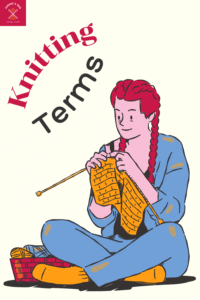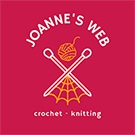These are some of the 100 most common knitting terms you’ll find when starting to knit or while knitting following a pattern. They are sorted in alphabetical order, for your convenience. Feel free to click over the blue highlight to read more about that term or watch a video tutorial on that specific method.
This resource includes links to our Amazon affiliate account—no extra charge to you.

100 Most Popular Knitting Definitions
-
Afghan: A smaller-sized crocheted or knitted blanket. Its origins relate to the crochet technique of Tunisian Aghan crochet.
-
Aran: a knitting technique that originates from the Irish west coast’s Aran Islands. Well-known for the use of detailed, textural designs that include bobbles, twists, diamonds, and cables. Traditionally, cream-colored, undyed wool is used to knit these designs, producing a thick, cozy cloth perfect for the harsher island weather.
-
Arm Knitting: A technique where the knitter uses their arms instead of needles to create large stitches. Creating large and very open fabric.
-
Armhole Shaping: Techniques used to create armholes in garmentsss.
-
Back Loop: The part of the stitch farthest from you. Located on the other side of the needle.
-
Bamboo Needles: Knitting needles made from bamboo.
-
Basketweave: A textured pattern resembling a woven basket. With contrasting textures to create the pattern.
-
Beading: Adding beads to knitting for decoration.
-
Bind Off: A method to finish a project and secure the stitches. There are many ways to bind off, some stretchy, some decorative and some simple.
-
Blocking: A process of wetting or steaming your knitting to set the shape, revealing its true size and prevent rolling of the edges.
-
Blocking Mats: Mats used for pinning and drying knitted items.
-
Brioche: A popular knitting technique that creates a thick, stretchy fabric, often using two contrasting colors.
-
Cable: This type of knitting design, creates twisted, rope-like patterns in knitting often in the form of braids or chains.
-
Cable Needle: A small needle used to hold stitches temporarily for cable knitting.
-
Cast On: The way to crate or ‘mounting’ the initial stitches on the needle.
-
Chart: A graphical visual representation of a knitting pattern. It includes a variety of symbols that represent a certain stitch or technique.
-
Chart Reading: The skill of interpreting knitting charts.
-
Circular Needles: Knitting needles connected by a flexible cable for knitting in the round. Most commonly used for circular items like hats, socks dresses or items knit without seams.
-
Colorwork: Techniques involving multiple colors of yarn in a project, arranged into different designs. Charts are often used for this type of knitting project.
-
Color Dominance: In knitting, the color that stands out more.
-
Continental Knitting: A style of knitting where the yarn is held in the left and carried to knit from the hand.
-
Cotton: A type of yarn made from cotton fibers.
-
Darning: Repairing holes in knitted fabric.
-
Decreasing: Reducing the number of stitches used on your knitting project. There are many decreases: from right or left-leaning to double or seamless.
-
DPNs (Double-Pointed Needles): Needles used for knitting in the round with a small circumference. They can also be used for larger projects like hats, dresses or even projects knitted in one pieces (seamless).
-
Drop Stitch: A common knitting mistake, where stitches fall from the knitting needle also a technique that intentionally drops stitches to create a decorative effect.
-
Dye Lot: A number indicating the batch in which the yarn was dyed. Ideally, all yarn needed for a project must be from the same dye lot.
-
Double Knitting: A technique creating a double-thickness fabric.
-
Edge Stitch: The first and last stitch of a row.
-
Entrelac: A knitting technique creating an overlapping, basketweave pattern.
-
Embellishments: Decorative elements added to knitting.
-
Fair Isle: A colorwork traditional knitting technique named after Fair Isle, one of the Shetland Islands in Scotland. The Fair Isle Designs create intricate motifs, typically geometric shapes like diamonds, crosses, and zigzags, using multiple colors to create patterns.
-
Fiber Blends: Yarn made from a mix of different natural or synthetic fibers to create a yarn.
-
Felted Knitting: Knitting that has been shrunk and matted with a felting tool.
-
Fiber: The material yarn is made from.
-
Finishing: The final steps of a project: from bind-off to blocking, sewing seams, and weaving in ends.
-
Flat Knitting: Knitting with two straight knitting needles in back and forth in rows, seaming later if needed.
-
Frogging: Undoing knitting to correct a mistake. Also known as TINKing (the reverse of KNIT).
-
Gauge: The number of stitches and rows per inch or centimeter. Most gauge are 4 inches (10cm)
-
Gauge Swatch: A sample used to measure stitch gauge.
-
Garter Stitch: A basic and most common stitch pattern where every row is knitted.
-
Hank: A length of yarn that is coiled into a loose twist. Must ideally ravel into a ball.
-
Hem: A folded-over edge of a knit to create double thickness.
-
I-cord: A narrow tube of knitting.
-
Intarsia: A colorwork technique for blocks of color that create intricate geometric designs, letters or more. Usually done in two or more colors.
-
Jacquard: A complex colorwork technique.
-
Kitchener Stitch: A method for grafting live stitches together, creating a pretty seamless look.
-
Knitting in the Round: A method of knitting around continuous tube, mostly used for garments like infinity scarves, sweaters knitted in one piece (no seams) and some hats.
-
Knit Stitch: A basic knitting stitch.
-
Lace Knitting: A technique that creates open, airy patterns. A popular type of knitting pattern.
-
Ladder: A column of dropped stitches in Knitting.
-
Lifeline: A strand of yarn threaded through stitches to prevent losing your place or dropping stitches.
-
Loom Knitting: Using a loom instead of needles to knit. Looms are usually round or spiral.
-
Magic Loop: A method for knitting small circumferences in the round using a long circular needle. Used mostly for sock or hat knitting.
-
Matinee Jacket: A small baby jacket.
-
Merino: A type of wool from Merino sheep.
-
Moss Stitch: A stitch pattern created by alternating knit and purl stitches. There are many types of moss stitches.
-
Multicolored Yarn: Yarn dyed with multiple colors. Depending on the type of color mixing, some of this multicolored yarn is: variegated, semi-solid, self-striping and speckled,.
-
Needle Gauge: A tool for measuring needle thickness and often includes a small ruler as well.
-
No-dye-lot Yarn: Yarn that doesn’t have dye lots.
-
Ombré: Yarn dyed to create a gradient effect.
-
Pilling: The formation of small fiber balls on the surface of knitted fabric. They can be shaved off with a special tool or a razor.
-
Ply: The number of strands twisted together to make yarn.
-
Pompom: A fluffy ball made with yarn and used as decoration on many knitting projects.
-
Provisional Cast-On: A temporary cast-on with scrap yarn that can be removed to add stitches later.
-
Purl Stitch: The opposite of a knit stitch, creating a bumpy texture.
-
Raglan: A style of sleeve that extends in one piece to the collar.
-
Row: A horizontal line of stitches.
-
Roving: Unspun wool used for spinning yarn or felting.
-
Seaming: Joining pieces of knitting together with a seam. There are many types of seaming: Kitchener, seamless, etc.
-
Selvage: The edge of a knitted piece.
-
Skein: A length of yarn wound into a coil.
-
Slip Stitch (sl): Moving a stitch from one needle to another without knitting it. Can be also done with the yarn in the back. (slpwyib)
-
Sock Knitting: Techniques and patterns for knitting socks.
-
Spinning: The process of twisting fibers into yarn.
-
Stash: A collection of yarn.
-
Stitch: A single loop of yarn in knitting.
-
Stitch Holder: A tool for holding many stitches while temporarily working on the garment.
-
Stitch Marker: A small ring used to mark a place in your knitting. Often used on more complex patterns like lace.
-
Stockinette Stitch: A fabric created by alternating knit and purl rows.
-
Stranded Knitting: A colorwork technique where yarn is carried across the back.
-
Swatch: A small knitted sample made to test gauge: Inches or centimeters per stitch.
-
Tapestry Needle: A large needle used for sewing seams and weaving in ends.
-
Tension: The tightness or looseness of your stitches.
-
Textured Knitting: Techniques creating a three-dimensional surface.
-
Toe-Up Socks: Socks knitted from the toe to the cuff.
-
Tunisian Crochet: A crochet technique that uses a longer crochet hook and passes the yarn through multiple stitches in varying sequences.
-
Twisted Stitch: A stitch where the loop is twisted.
-
UFO (Unfinished Object): A project that has been set aside.
-
Variegated Yarn: Yarn dyed with multiple colors.
-
Worsted Weight: A medium-thickness yarn.
-
WPI (Wraps Per Inch): A measure of yarn thickness.
-
Yarn: The material used for knitting, made from fibers.
-
Yarn Bowl: A bowl designed to hold yarn while knitting.
-
Yarn Forward: Also referred to as Yarn Over, it’s keeping the yarn on the purl side while making the next stitch.
-
Yarn Swift: A tool for holding a hank of yarn while it’s wound into a ball.
-
Yarn Over: Creating an extra loop over the needle.
-
Yoke: The part of a garment that fits around the shoulders.
-
Z-twist: A yarn spun in a counterclockwise direction.

![How To Knit [Beginner's Guide] How To Knit [Beginner's Guide]](https://joannesweb.com/wp-content/uploads/2024/07/Knitting-Basics.png)


0 Comments